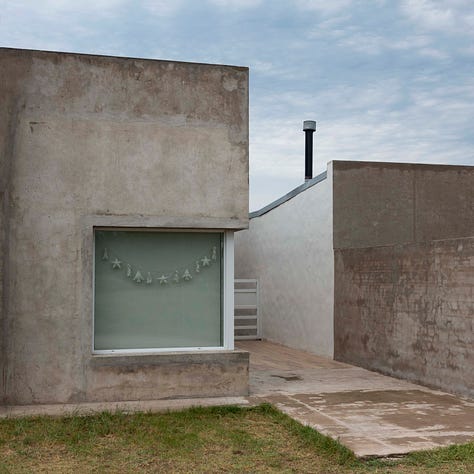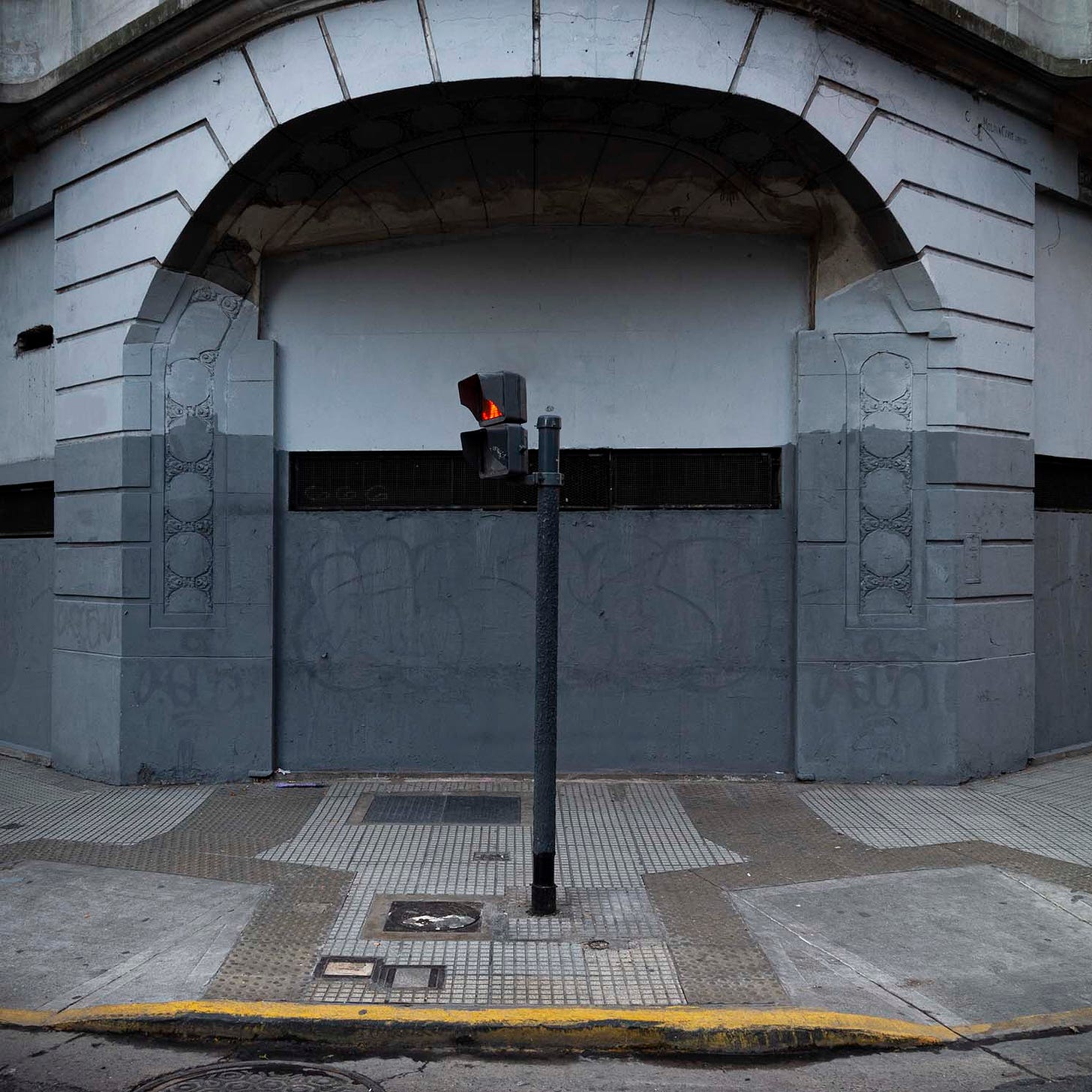Walking with Intent: Juan Travnik’s “Materia”
Arturo Soto explores how a modern photographic flâneur captures the transition from deindustrialization to gentrification in Buenos Aires.
The photobook Materia by the Argentinian Juan Travnik offers the perspective of a modern flâneur collecting images of street corners, windows, and architectural facades that he discovered during his early morning walks in Buenos Aires, the suburb of Campana and the beach town of Claromecó, where he spends his summers.
The neighborhoods he captures bear the kind of neglect that often marks their transition from deindustrialization to gentrification. People are absent in these images, but we can infer their engagement with the environment through traces of their activities. Some of these are evidenced in the wear and tear of materials, but there are a few cases that feel like the product of small acts of violence that could not be repressed any longer. Travnik’s method is characterized by an open mind and a hungry eye for discovering subjects that can be given new meanings through photography.
Travnik’s precise framing establishes a logic of abstraction by isolating the structures from their broader spatial contexts, an approach that gives the pictures a playful ambiguity. However, in a genre like documentary photography, where audiences often prefer reacting to dramatic events, Travnik’s acute formalism might make the social reality behind these structures less noticeable. This paradox is further intensified by the book’s restrained chromatic palette, dominated by dark grays and blues that give a false sense of solidity in a country that has characterized itself in recent times for its chaotic politics. Yet, if we look closely, this commitment to formal compositions based on lines, squares, and rectangles insinuates a permanent state of instability rather than visual playfulness, adding a layer of intricacy to the images.
Travnik made the pictures during the pandemic, which can make Materia seem like a quintessential lockdown project, but judging it solely in relation to this event would be reductive. While some of the pictures could suggest Travnik’s angst toward the future, they do not systematically reflect the social conditions produced by the global emergency.
Given Travnik’s extensive oeuvre, it can also be tempting to interpret Materia based on his previous projects, most of which dissect political aspects of Argentina’s recent history. For example, in a series like Malvinas: Retratos y Paisajes de Guerra, comprised of portraits of soldiers who fought in the Falkland War and landscapes of the sites where the conflict occurred, politics can hardly be disentangled from its subject matter. In other cases, as with Bancos, which documents the boarded-up facades of international banks like HSBC and Lloyd’s after the financial collapse of the early 2000s, the political subtext is less visible, but it is equally inextricable from the project.



Pondering the degree to which an artist’s oeuvre should dictate the interpretation of their recent work is essential because relying on interpretive conventions can be misleading. Although it is problematic when political readings are ascribed to works due to characteristics beyond the artist’s control – such as their nationality, heritage, or age – I am more concerned here with instances in which a work’s inherent characteristics are overlooked in favor of ready-made statements and customary value judgments (how some constituencies exploit this for financial gain is a topic for another time). On top of this, there is the artists’ position to consider. Sometimes, they want to change course and explore different subjects or techniques but feel trapped in becoming the spokespeople of a cause.
Travnik’s projects tend to capture how a landscape reflects the zeitgeist through markers that make its sociopolitical context more explicit. With a few exceptions, like a torn poster denouncing food cost inflation, most images in Materia do not contain such overt markers. Instead, this book is one of those cases in which the pictures are too dissimilar to fit an overarching interpretation. In other words, the only identifiable marker present in all the pictures is their absence of instrumentality, which suggests that building a political argument was not Travnik’s preferred line of inquiry (it bears reminding that the photographs predate Javier Milei’s election and the tumultuous response it aroused).
Curiously, the book’s title points in another direction, which, according to Travnik, emerged out of conversations with the curator Alexis Fabry, who associated the picture’s abstract qualities with the energetic paintings of Informalismo, a midcentury artistic movement characterized by gestural abstraction and thick layers of impasto that emphasized the materiality of the picture plane. Indeed, it is possible to see echoes of this style in a few pictures, like the Art Deco building that has suffered a lingering struggle between cleaners and graffiti artists. Yet, this art-historical allusion might be apparent only to those who visited the exhibition at the Fundación Larivière that featured the whole series plus a couple of paintings by some of the movement’s most renowned proponents, Clorindo Testa and Noemí Di Benedetto. Otherwise, while not necessarily forced, the connection with Informalismo feels merely anecdotal.
Travnik is an influential figure – he managed a gallery for seventeen years and leads the only photography degree in his country – who has fabricated an idiosyncratic version of Buenos Aires through an elaborate body of work. In this sense, Materia is only the latest manifestation of his desire to apprehend the ethereal identity of the capital. For this reason, Travnik has resisted formulating a clear-cut discourse that explains his motivations. While some artists are eager to promote specific readings of their work, Travnik is content to let his images do the rhetorical heavy lifting.
Since the conceptions Materia evokes can go in many different directions, it is impossible to know how the factual information they contain will be processed in years to come when their formalism has coalesced into a more transparent window to the past or become completely intolerable. In either case, it will remain the viewers’ responsibility to determine how best to understand Travnik’s surrender to the thrill of the find when he thought the only appropriate response to what stood before him was to take out his camera and make a picture.
Arturo Soto is a Mexican photographer, writer, and educator. He has published the photobooks In the Heat (2018) and A Certain Logic of Expectations (2021). Arturo holds a Ph.D. in Fine Art from the University of Oxford, an MFA in Photography from the School of Visual Arts in New York, and an MA in Art History from University College London. He lives in Wales and is a Lecturer in Photography at Aberystwyth University.
Arturo writes a series of reviews on Latin American photographers for Dispatches: The VII Insider Blog. Check out his other articles:
The Possibilities of the Actual: Adriana Lestido’s "Metropolis"
Pablo Hare: Sites of Exploitation in Peru
Feeling Out the Past: Graciela Iturbide’s “Heliotropo 37”
A Masked Profession: Federico Estol’s “Shine Heroes”
The Persuasions of Disobedience: Ana María Lagos
Messages of Angst and Hope: “Notas De Voz Desde Tijuana”
The Politics of Window Shopping: Pablo López Luz's “Baja Moda”
Life in a Lawless Town: Juan Orrantia’s “A Machete Pelao”
The Disenchanting Hunt for the Truth: Christo Geoghegan’s “Witch Hunt”
Erasure as a Method of Exposure
The Political Price of Dreams: Pablo Cabado’s "Little Suns on Earth"
The Infinite Resonances of a Single Word: Marisol Mendez’s "Madre"









